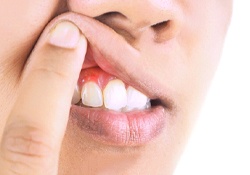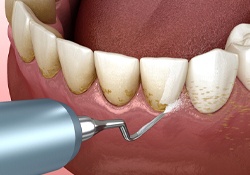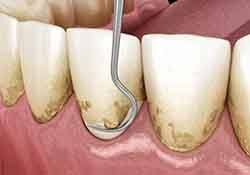


Gum disease is far more common than you probably think; over half of adults over 30 in the United States have some form of the condition. If it’s not treated, you could lose your teeth, and your overall health could suffer. Luckily, Dr. Kirby can use periodontal therapy to treat the disease and save your smile. If you believe your gums are infected (or if it’s been more than six months since they were examined at a preventive checkup), call us to schedule an appointment today.

Gum disease (often called “periodontal disease” by dentists) is when the tissues that hold your teeth in your mouth become infected. The cause is usually bacteria in your mouth that hasn’t been removed by brushing or flossing; other risk factors include smoking, diabetes, hormonal changes in women, dry mouth, and certain illnesses that weaken the immune system.
The earliest form of gum disease is gingivitis. If it isn’t treated, it eventually becomes periodontitis. At that point, you’ll be in danger of losing your teeth. Furthermore, patients with gum disease have been found to be at a higher risk for heart attacks, respiratory illnesses, and Alzheimer’s disease. In other words, if you don’t get treatment quickly, the long-term consequences could be very severe.

Unfortunately, gum disease is often silent. That means you might not even notice the symptoms until you’re in the more advanced stages that are much harder to treat. Dr. Kirby can examine your gums during your biannual dental checkups; that way, he’ll be able to find warning signs you might have missed and take the appropriate preventive actions.
That said, possible warning signs of gum disease include:

There are plenty of choices when it comes to safe, effective periodontal therapy. Depending on the situation, we might suggest:

Even though you might be brushing, flossing, and rinsing with mouthwash every day to maintain your oral health, sometimes the gums can still accumulate bacteria that can lead to more advanced periodontal disease. If our team detects this issue, we can typically reverse the effects through scaling and root planing. Not only will this clear up plaque and tartar surrounding the gum line, but it can also help prevent your teeth from becoming loose or falling out later on. Feel free to reach out to our office if you’d like to schedule an appointment or read on to get a closer look at these two procedures so that you know what to expect.

In most cases, those who are struggling with the early signs of periodontal disease or gingivitis can generally fix this problem with a strict cleaning routine, such as brushing, flossing, and regular appointments for professional teeth cleaning. For more advanced gum infection, scaling and root planing might be necessary to resolve the issue, as the bacteria can develop inflammation around the gums, causing them to separate from the teeth while forming deep pockets. With these services, we can effectively remove all the trapped plaque and tartar so that the gum tissue has a chance to recover from disease.

Similar to other dental procedures, our team will first numb your mouth so that we can perform the treatment without causing you discomfort in the process. The initial portion is called scaling, otherwise known as “deep cleaning,” which involves getting rid of any plaque from the top surface of your teeth as well as around and beneath the gum line. You’ll then wait a week or so until your next appointment so that you can heal.
The next part of the process is root planing, which consists of exposing the root surfaces and making them smoother. Not only does this clean the area of plaque and improve gum regeneration, but it also makes it much more difficult for bacteria to accumulate, which can protect you from future infection. Your periodontal tissue will also be able to attach to your teeth more easily, enhancing your oral health in the long run.

After both treatments are done, you’ll likely feel soreness or mild discomfort once the numbing effects of the local anesthetic wear off. For this reason, it’s best to avoid eating anything solid so that you don’t accidentally chew on your tongue or cheeks. Stick with more liquid foods and drinks. Be sure to also rinse with salt water frequently, as this can help minimize pain and swelling as well as keep your mouth disinfected during your recovery. If you notice any symptoms of discomfort or infection, notify us for help.